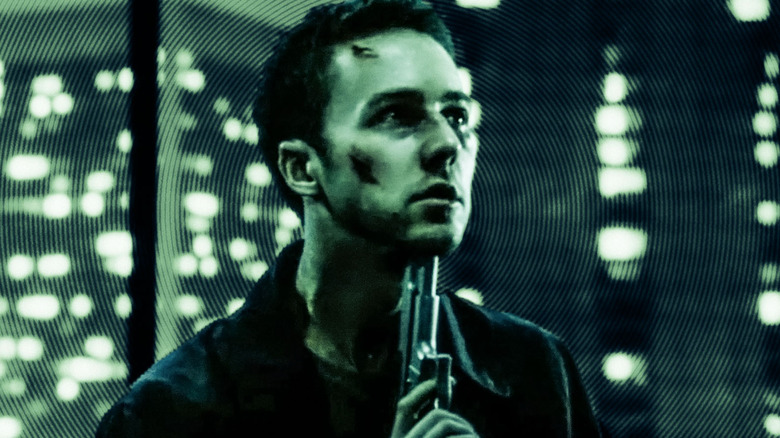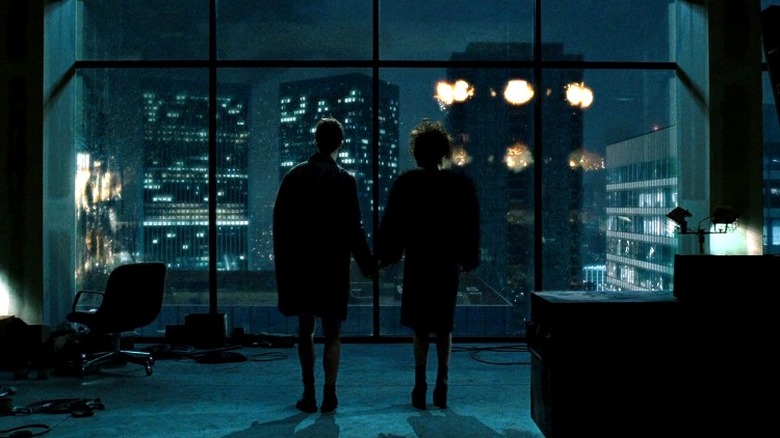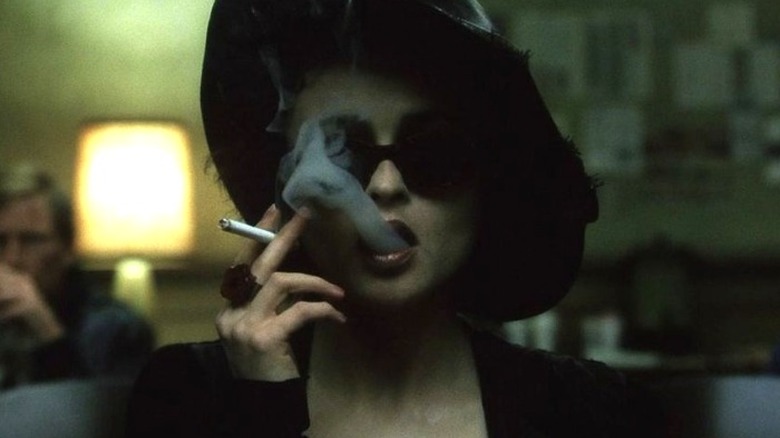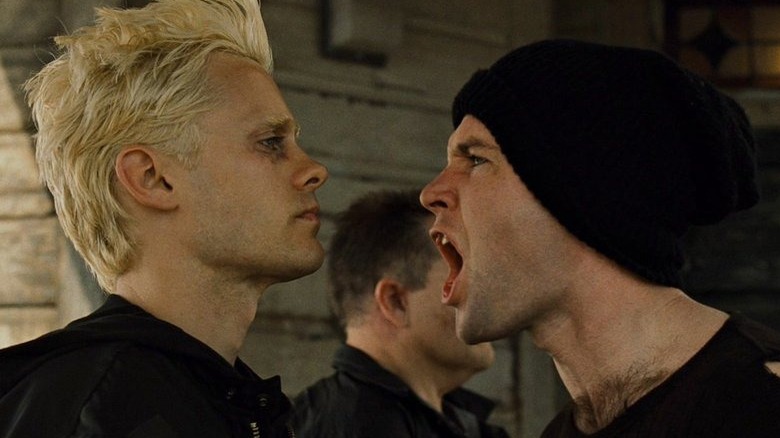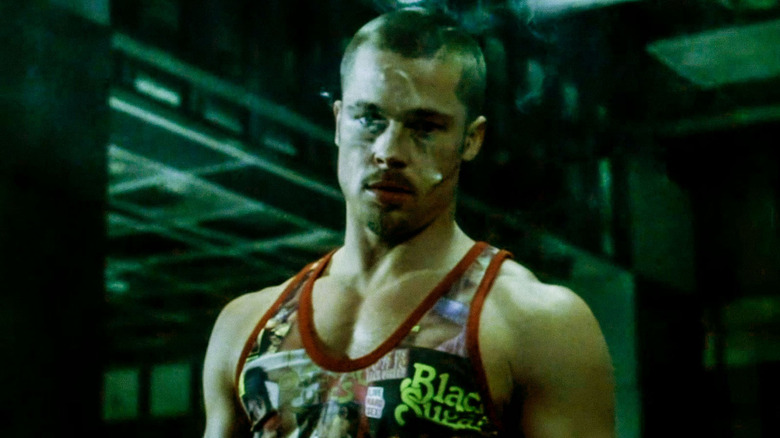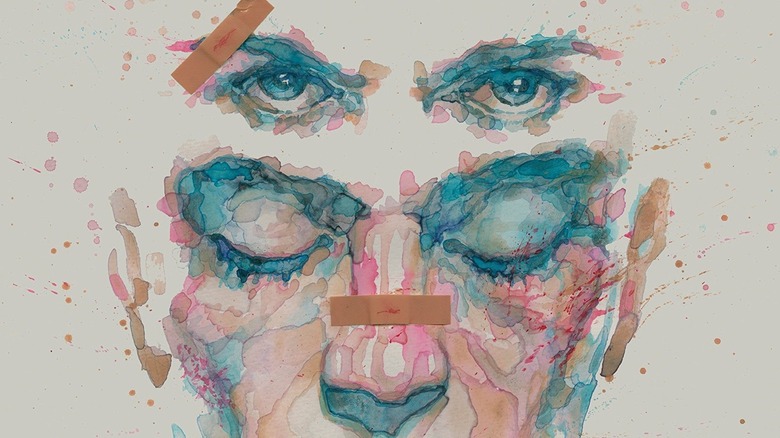Fight Club Ending Explained: I Am Jack's Lack Of Confusion
The first rule of Fight Club is to never talk about it — but rules are made to be broken. David Fincher's 1999 film "Fight Club," based on the 1996 novel of the same name by Chuck Palahniuk, was extremely controversial upon release and has become a cult classic in the years since.
One thing that still polarizes audiences is the shocking twist ending, which isn't nearly as explicitly explained in the movie as in its source material. Buckle up, space monkeys, because it's time to break down the ending of "Fight Club."
Where is My Mind?
In "Fight Club," the nameless narrator (Edward Norton) befriends a strange man named Tyler Durden (Brad Pitt). After his condo is destroyed by a freak explosion, the narrator moves in with Durden at his ramshackle abode on Paper Street, where they start making soap together. They also start having meetings in the basement of a local bar where they beat the crud out of one another. More men start joining in their "fight club," and soon they have a small army at their disposal. Tyler steps things up a bit with a new organization, Project Mayhem, which uses terrorist tactics to try to turn people away from capitalism. When the narrator tries to distance himself from Tyler, he discovers that's completely impossible. Why?
Because the narrator is Tyler. Tyler is the narrator. They are two personalities within one man, created because the narrator suffered a mental break and imagined his perfect alternate self: Tyler. The narrator suffers from insomnia, but in reality he is out Tyler's life while he thinks he's dozing on the couch.
The narrator tries to stop Tyler's final destructive plan, which will wipe out all debt by blowing up ten skyscrapers that house servers for the world's largest banks. He and Tyler have a bizarre one-man fight that ends with the narrator putting a gun in his mouth and pulling the trigger – killing Tyler, but not himself. He's too late to stop Project Mayhem, however, and the buildings begin to collapse as the narrator/Tyler's girlfriend, Marla Singer (Helena Bonham Carter), finds him and takes his hand.
The haunting notes of Pixies' "Where is My Mind?" play as Marla and the narrator watch the explosions, and the movie ends without much more explanation. But even after the credits roll, several major questions are left to linger in the minds of the audience.
How (and Why) the Narrator Created Tyler Durden
So why (and how) did the narrator invent Tyler Durden? In both the novel and the movie, the narrator says, "I know this because Tyler knows this" — even before the reveal of their shared physical identity. While we could interpret this as Tyler and the narrator having a freakishly close friendship, it also hints at the fact that they are one and the same. In both Palahniuk's novel and Fincher's movie, the narrator suffers from an extreme, fictionalized version of dissociative identity disorder. People with this disorder develop alternate personalities completely separate from their main identity, usually as a response to trauma. In the narrator's case, he was simply so depressed and tired of life that he developed Tyler as a way to cope.
Tyler works night jobs, while the narrator works day jobs. Whenever the narrator sleeps, Tyler is awake, wreaking havoc and sowing the seeds of Fight Club and Project Mayhem. He even plants the explosives in the narrator's apartment that force him to move into the house on Paper Street. According to the narrator, "Tyler had been around for a long time before we met," which means he's been living a secret double life for quite some time.
But why create this alternate identity? The narrator was miserable; the only way he could get to sleep at night was by attending support group meetings for the terminally ill. When he started running into Marla, another "tourist" at the support groups, his bizarre form of therapy stopped working. As a result, his mind split into Tyler. Tyler is everything the narrator isn't: he's sexy, he's charming, and he's not afraid to challenge the status quo.
Marla Singer is the only person who gets close enough to both Tyler and the narrator to figure out there might be some kind of split, but even she's not sure. She hears them having conversations with one another and asks who Tyler is talking to, but she doesn't really question it further. In the novel Marla speaks to the dead through phone lines, so maybe she just chalks it up to Tyler being as unusual as she is.
What Is the Purpose of Project Mayhem?
Project Mayhem is an offshoot of Fight Club, created to take the teachings to another level. When the narrator no longer finds catharsis from visiting support groups, he needs some other way to feel. His neatly manicured, IKEA-catalogued life leaves him feeling numb, so when he and Tyler first fight, it brings new life into his meaningless existence.
Tyler posits that men need to fight because they have been over-feminized by consumerism; Project Mayhem takes that a step further by trying to remove all aspects of consumerist life. Personal identity doesn't matter anymore, as the members of Project Mayhem move into the house on Paper Street and shave their heads to become like "space monkeys." Tyler repeats mantras like "you are not a unique and individual snowflake" while the members of Project Mayhem do his dirty work.
Both Fight Club and Project Mayhem allow outlets for these men's repressed emotions. They can take out their rage on one another and on "the system," losing themselves in Tyler's vision. Tyler eventually wants to remove all capitalism returning the world to a time he believes was more pure:
"In the world I see you are stalking elk through the damp canyon forests around the ruins of Rockefeller Center. You'll wear leather clothes that will last you the rest of your life. You'll climb the wrist-thick kudzu vines that wrap the Sears Towers. And when you look down, you'll see tiny figures pounding corn, laying stripes of venison on the empty car pool lane of some abandoned superhighways."
Why Does Tyler Die When the Narrator Shoots Himself?
One thing script writer Jim Uhls did when translating Palahniuk's novel for the screen was streamline the story. Durden's many gripes with society were reduced to a hatred for capitalism, the various members of their organizations became nameless, and Marla's story was heavily cut. While this makes for a more cohesive movie, it also removes some of the ways Palahniuk had ensured the story made sense. Some of what Tyler does in the movie was actually done by Angelface (Jared Leto) or Robert Paulson (Meat Loaf), which makes more sense since they're real people and not figments of the narrator's imagination/his alternate self.
In the novel, the narrator fires the gun in his own mouth, but the bullet exits beneath his ear. Tyler disappears when Marla arrives because Tyler "was his hallucination, not hers." The narrator is taken to a mental hospital, which he believes to be the afterlife, and Marla visits him sometimes.
In the movie, Tyler dies the moment the narrator pulls the trigger because the narrator has made the conscious decision to destroy Tyler. Arguably more important than the act of shooting himself are the words he says to Tyler beforehand:
"Tyler, I want you to listen to me very carefully ... My eyes are open."
The death is more symbolic than literal, because Tyler is technically only a figment of the narrator's imagination. Telling Tyler that his eyes are open is the narrator's way of saying that he doesn't need Tyler any more (and, more importantly, meaning it).
The Complicated Legacy of Fight Club
It's tough to talk about "Fight Club," in part because it's an indictment of toxic masculinity that also happens to make toxic masculinity look really, really cool. The film's mixed messaging and ultra-violence has made it a lasting source of controversy. No one can entirely seem to agree on whether it's a searing satire or if the glamorization of bad behavior makes it just as harmful as what it's allegedly satirizing.
Palahniuk made things even more complicated with "Fight Club 2," a graphic novel that takes place after the narrator has been freed from the hospital and is married to Marla. They live in the suburbs, with a white picket fence and everything, when Tyler comes back to wreak havoc. The graphic novel received mixed reviews and doesn't give any concrete answers about the questions posited in "Fight Club," making it a frustrating read.
No one has all of the answers about "Fight Club," but thanks to its controversial legacy, we'll always be breaking the first rule.
